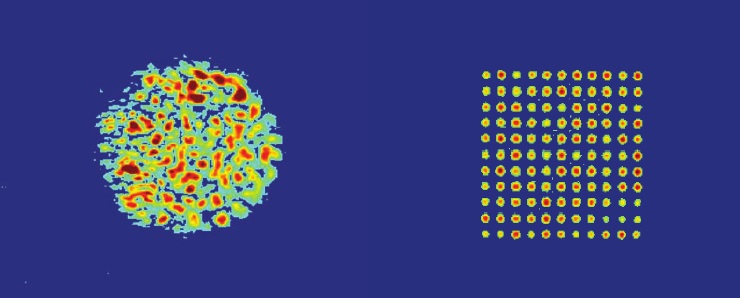31 Jan 2017
Professor Robert Thomson and his team, working in collaboration with physicists and engineers at the Universities of Bath and Edinburgh, have massively increased the technique’s potential applications. The team has multiplexed its detection capability by over two orders of magnitude, using advanced multicore optical fibres, photonic lanterns and single-photon-sensitive detector arrays.
In many cases, the most useful form of light is as a series of optical pulses, rather than a continuous stream. Previously, measuring the colours of light that form these pulses often required bulky and expensive instruments. One approach is to use a technique known as time-stretch spectroscopy, but this technique has, until now, had limited applications outside the lab.
Professor Thomson and his team have created a new way to analyse these colours, using advanced photonic devices, such as photonic lanterns, multicore optical fibres and single-photon detector arrays.
Professor Thomson explained, “Optical fibres are long threads of glass that guide light in a manner similar to the way electrical wires guide electrons
“Time-stretch spectroscopy relies on the fact that the different colours of light that form an optical pulse travel at different velocities in an optical fibre.
“By coupling a short optical pulse into one end of the fibre, and using it as a "time-lens", we can rip the individual colours of light apart. By measure the arrival times of individual photons at the opposite end of the fibre, we can infer the colours of the individual arriving photons, and construct the spectrum of the input pulse.
Conventionally, time-stretch spectroscopy has used conventional ‘single-mode’ optical fibres, where the light is guided in a single high refractive index core region in the middle of the fibre. Unfortunately, the use of these fibres severely limited the real-world applications of this technique
Professor Thomson said, “In this work, we have shown that multicore fibres and advanced single-photon sensitive detector arrays can be used to perform ‘multiplexed’ time-stretch spectroscopy, where we simultaneously process and detect over 100 individual single-mode channels.
Crucially, we have also demonstrated that advanced photonic devices, known as ‘photonic-lanterns’ can be used to efficiently couple light from the real world to these multicore fibres. This is a key step that holds great promise for real-world applications.
Professor Robert Thomson
The multiplexing technologies reported by Professor Thomson’s team has the potential to dramatically increase the achievable efficiency using time-stretch spectroscopy, enabling new applications such as highly sensitive spectrometers for pathogen detection, and photon-number resolving detectors for quantum optics.
Read Professor Thomson's Nature Communication paper in full here.













